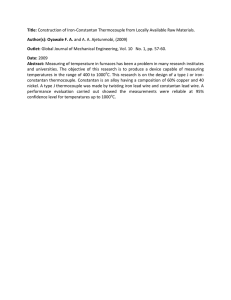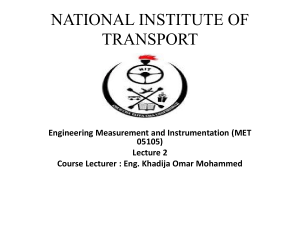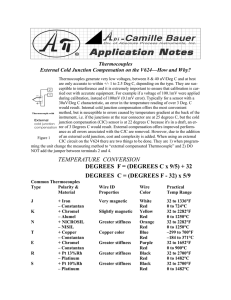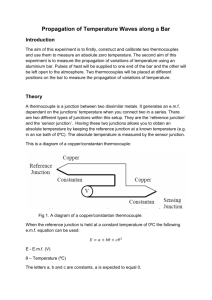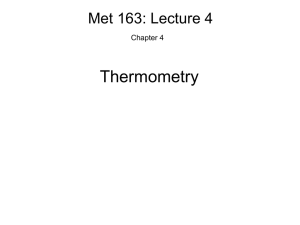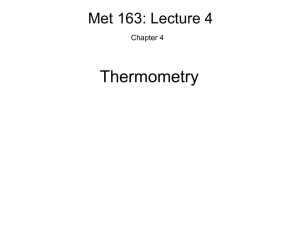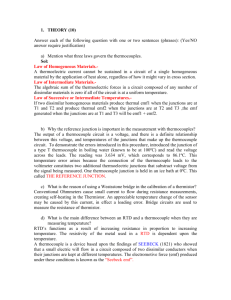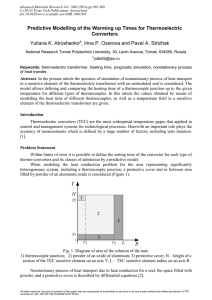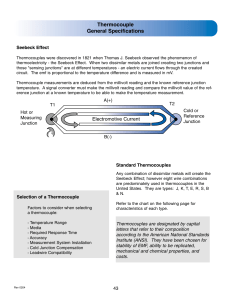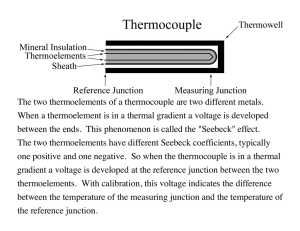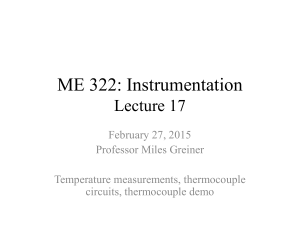Temperature Measurement The Thermocouple
advertisement
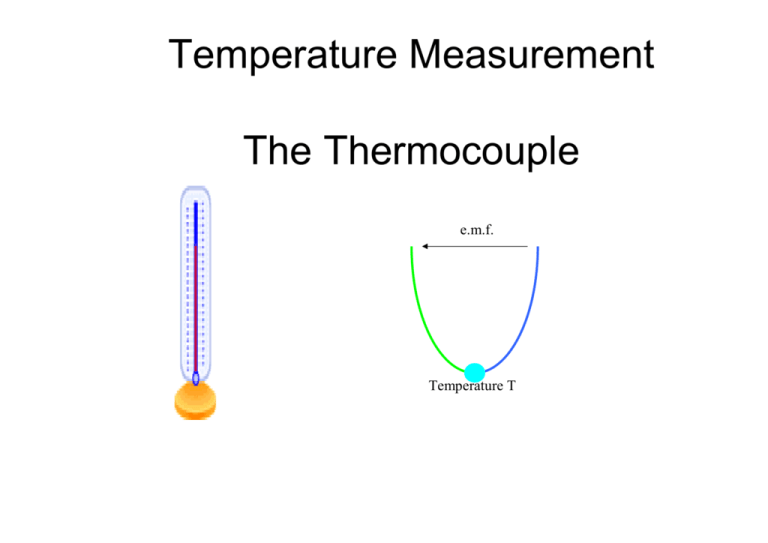
Temperature Measurement The Thermocouple e.m.f. Temperature T Learning Outcomes After this lecture you should be able to… • Explain the thermoelectric effect • Explain how a thermocouple works • Write the equation that relates the millivolt output from the thermocouple and temperature • List the different types of thermocouples available • Explain the laws of thermocouples • Show how a thermocouple is used to measure temperature • Reference the thermocouple tables Thermocouple The thermoelectric effect – when two different metals are joined together an electromotive force (e.m.f.) is generated. The amount of e.m.f. is proportional to the junction temperature e.m.f. e.m. f . = aT Temperature T Linear between temperature and e.m.f. Thermocouple is a couple of these junctions (both the same) Overall e.m.f. is the difference between the two individual e.m.f.s Thermcouple, i.e. 2 junctions e.m.f.1 T1 T1 e.m.f.2 An e.m.f. is generated at each junction We want to know the difference in the e.m.f.s V = e.m.f.1 – e.m.f.2 V = aT1 – aT2 V = a(T1 – T2) T2 T2 Equation If we know one temperature and measure the e.m.f. we can predict the other temperature e.m. f . = a (T1 − T2 ) Cold junction – ideally we keep one junction at 0 °C Measuring junction – placed in the unknown temperature a = sensitiviy. It depends on the particular pairing of metals. For Chromel and Alumel, a = 41 µV/°C. For Platinum and Platinum+Rhodium Alloy, a = 8 µV/°C. Thermcouple Types Type Materials Range °C a. µV/°C Cost E Chromel Constantan 0 to 980 63 Cheap J Iron Constantan -180 to 760 53 Cheap K Chromel Alumel -180 to 1260 41 Cheap R Platinum Platinum/Rhodium Copper Constantan 0 to 1750 8 Dear -180 to 370 43 Cheap T History Thermocouple operation (I.e. generation of e.m.f.) is a physical phenomenon known as the Thermoelectric effect or also called the Seebeck effect. It is named after Thomas Johann Seebeck (1770 – 1831) who was born in Estonia and educated in Germany. In 1821 he discovered that joining semicircular pieces of bismuth and copper together caused a magnetic disturbance on a nearby compass needle. He also discovered that a voltage existed between two ends of a metal bar that had a temperature gradient, i.e. the temperature of the bar increased along its length. He did not make the connection that Faraday made 10 years later (1831, the year Seebeck died) that the needle disturbance was caused by a magnetic field created by an electric current due to the generation of the e.m.f. Instead he incorrectly attributed the behaviour to an effect he called thermomagnetism. Thermcouple Table – Type K °C 0 1 2 3 4 5 6 7 8 9 10 °C 0 0.000 0.039 0.079 0.119 0.158 0.198 0.238 0.277 0.317 0.357 0.397 0 10 0.397 0.437 0.477 0.517 0.557 0.597 0.637 0.677 0.718 0.758 0.798 10 20 0.798 0.838 0.879 0.919 0.960 1.000 1.041 1.081 1.122 1.163 1.203 20 30 1.203 1.244 1.285 1.326 1.366 1.407 1.448 1.489 1.530 1.571 1.612 30 40 1.612 1.653 1.694 1.735 1.776 1.817 1.858 1.899 1.941 1.982 2.023 40 Activity - Thermocouples Activity 1 - Read the handout on the Laws of Thermocouples and identify which laws apply to the following scenario. Steam Supply 120 - 160 degC = T1 Control Room 15 - 30 degC = T3 Plant Room 30 - 50 degC = T2 e.m.f. = VT3, 0 T3 V T1 T2 e.m.f. Copper Alumel Chromel Extension leads through building varying temp Activity - Thermocouples Use the thermocouple tables to solve this problem. In a similar situation to the above example, the voltmeter in the control displays a reading of 5.4 mV. A thermometer on the wall of the control room displays a temperature of 22 °C. What is the temperature of the steam in the pipe Steam Supply = ? degC Control Room = 22 degC e.m.f. = 5.4 mV Alumel Chromel Type K Conversion Table To K (Kelvin) °C (Celsius) °F (Fahrenheit) °R (Rankine) TK K 1 TK - 273.15 9/5TK – 459.67 5/9TK TC °C TC + 273.15 1 9/5TC + 32 5/9TC + 151.75 TF °F 5/9TF + 255.37 5/9TF – 17.8 1 0.308TF + 141.9 TR °R 9/5TR 9/5TR – 273.15 3.24TR – 459.67 1 From For example, what is 46 °C in Kelvin? TC = 46 so Kelvin = TC + 273.15 = 319.15 K Exercise, what is 46 °C in Fahrenheit?
